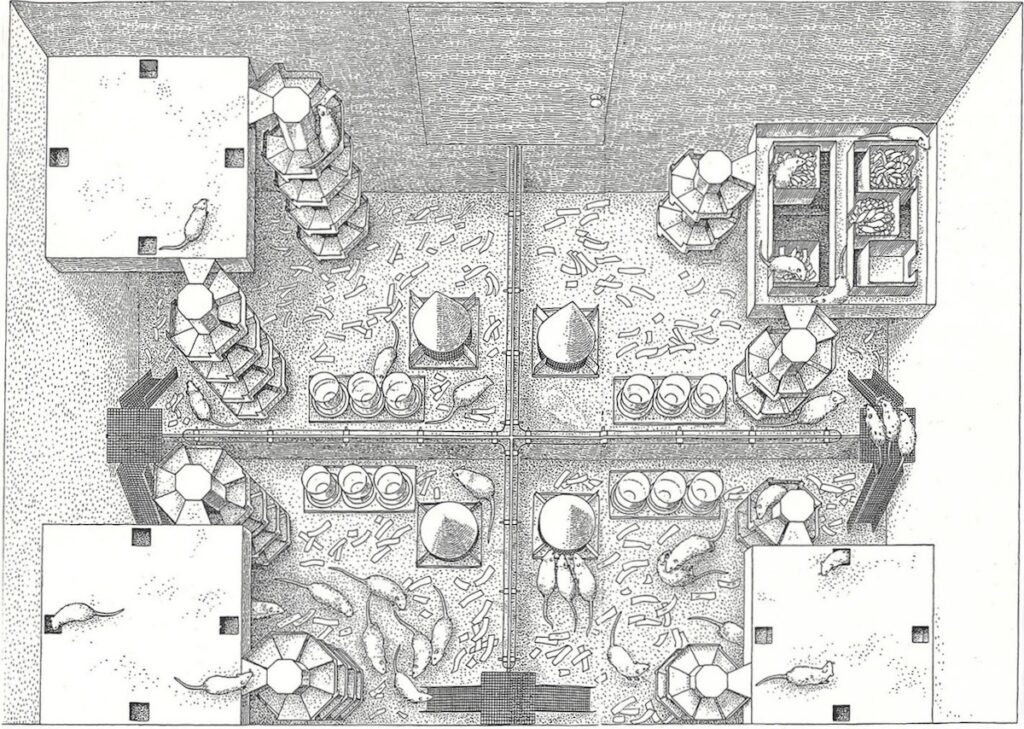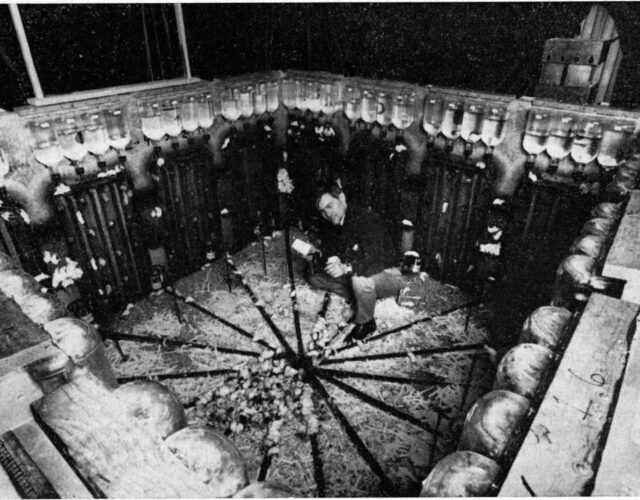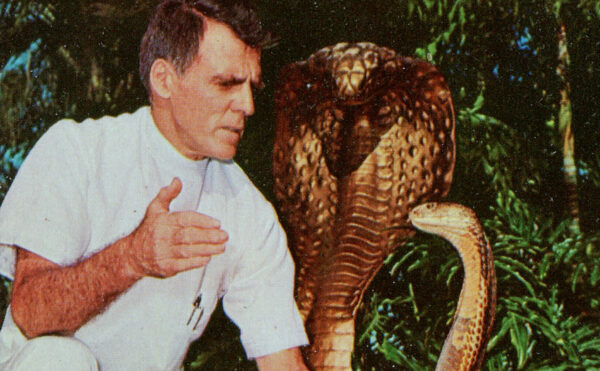Officially, the colony was called the Mortality-Inhibiting Environment for Mice. Unofficially, it was called mouse heaven.
Biologist John Calhoun built the colony at the National Institute of Mental Health in Maryland in 1968. It was a large pen—a 4½-foot cube—with everything a mouse could ever desire: plenty of food and water; a perfect climate; reams of paper to make cozy nests; and 256 separate apartments, accessible via mesh tubes bolted to the walls. Calhoun also screened the mice to eliminate disease. Free from predators and other worries, a mouse could theoretically live to an extraordinarily old age there, without a single worry.
But the thing is, this wasn’t Calhoun’s first rodent utopia. This was the 25th iteration. And by this point he knew how quickly mouse heaven could deteriorate into mouse hell.
John Calhoun grew up in Tennessee, the son of a high school principal and an artist, and was an avid birder when young. After earning his PhD in zoology, he joined the Rodent Ecology Project in Baltimore in 1946, whose purpose was to eliminate rodent pests in cities. The project had limited success, partly because no one could figure out what aspects of rodent behavior, lifestyle, or biology to target. Calhoun set up his first utopia, involving Norway rats, in the woods behind his house to monitor rodents over time and figure out what factors drove their population growth.
Eventually Calhoun grew fascinated with the rodent behavior for its own sake and began crafting ever more elaborate and carefully controlled environments. It wasn’t just the behavior of rats that interested him. Architects and civil engineers at the time were having vigorous debates about how to build better cities, and Calhoun imagined urban design might be studied in rodents first and then extrapolated to human beings.
Calhoun’s most famous utopia, number 25, began in July 1968, when he introduced eight albino mice into the 4½-foot cube. Following an adjustment period, the first pups were born 3½ months later, and the population doubled every 55 days afterward. Eventually this torrid growth slowed, but the population continued to climb, peaking at 2,200 mice during the 19th month.
That robust growth masked some serious problems, however. In the wild, infant mortality among mice is high, as most juveniles get eaten by predators or perish of disease or cold. In mouse utopia, juveniles rarely died. As a result, there were far more youngsters than normal, which introduced several difficulties.
Rodents have social hierarchies, with dominant alpha males controlling harems of females. Alphas establish dominance by fighting—wrestling and biting any challengers. Normally a mouse that loses a fight will scurry off to some distant nook to start over elsewhere.
But in mouse utopia, the losing mice couldn’t escape. Calhoun called them “dropouts.” And because so few juveniles died, huge hordes of dropouts would gather in the center of the pen. They were full of cuts and ugly scars, and every so often huge brawls would break out—vicious free-for-alls of biting and clawing that served no obvious purpose. It was just senseless violence. (In earlier utopias involving rats, some dropouts turned to cannibalism.)
Alpha males struggled, too. They kept their harems in private apartments, which they had to defend from challengers. But given how many mice survived to adulthood, there were always a dozen hotshots ready to fight. The alphas soon grew exhausted, and some stopped defending their apartments altogether.
As a result, apartments with nursing females were regularly invaded by rogue males. The mothers fought back, but often to the detriment of their young. Many stressed-out mothers booted their pups from the nest early, before the pups were ready. A few even attacked their own young amid the violence or abandoned them while fleeing to different apartments, leaving the pups to die of neglect.
Eventually other deviant behavior emerged. Mice who had been raised improperly or kicked out of the nest early often failed to develop healthy social bonds, and therefore struggled in adulthood with social interactions. Maladjusted females began isolating themselves like hermits in empty apartments—unusual behavior among mice. Maladjusted males, meanwhile, took to grooming all day—preening and licking themselves hour after hour. Calhoun called them “the beautiful ones.” And yet, even while obsessing over their appearance, these males had zero interest in courting females, zero interest in sex.
Intriguingly, Calhoun had noticed in earlier utopias that such maladjusted behavior could spread like a contagion from mouse to mouse. He dubbed this phenomenon “the behavioral sink.”
Between the lack of sex, which lowered the birth rate, and inability to raise pups properly, which sharply increased infant mortality, the population of Universe 25 began to plummet. By the 21st month, newborn pups rarely survived more than a few days. Soon, new births stopped altogether. Older mice lingered for a while—hiding like hermits or grooming all day—but eventually they died out as well. By spring 1973, less than five years after the experiment started, the population had crashed from 2,200 to 0. Mouse heaven had gone extinct.
Universe 25 ended a half century ago, but it continues to fascinate people today—especially as a gloomy metaphor for human society. Calhoun actively encouraged such speculation, once writing, “I shall largely speak of mice, but my thoughts are on man.” As early as 1968, journalist Tom Wolfe titled an essay about New York “O Rotten Gotham—Sliding Down into the Behavioral Sink.” Oddly, though, none of the prognosticators could agree on the main lesson of Universe 25.
The first people to fret over Universe 25 were environmentalists. The same year the study began, biologist Paul Ehrlich published The Population Bomb, an alarmist book predicting imminent starvation and population crashes due to overpopulation on Earth. Pop culture picked up on this theme in movies, such as Soylent Green, where humans in crowded cities are culled and turned into food slurry. Overall, the idea of dangerous overcrowding was in the air, and some sociologists explicitly drew on Calhoun’s work, writing: “We . . . take the animal studies as a serious model for human populations.” The message was stark: Curb population growth—or else.
More recently scholars saw similarities to the Industrial Revolution and the rise of modern urban society. The 19th and 20th centuries saw population booms across the world, largely due to drops in infant mortality—similar to what the mice experienced. Recently, however, human birth rates have dropped sharply in many developed countries—often below replacement levels—and young people in those places have reportedly lost interest in sex. The parallels to Universe 25 seem spooky.
Behavioral biologists have echoed the eugenics movement in blaming the strange behaviors of the mice on a lack of natural selection, which in their view culls those they consider weak and unfit to breed. This lack of culling resulted in supposed “mutational meltdowns” that led to widespread mouse stupidity and aberrant behavior. (The researchers argued that the brain is especially susceptible to mutations because it’s so intricate and because so many of our genes influence brain function.)
Extrapolating from this work, some political agitators warn that humankind will face a similar decline. Women are supposedly falling into Calhoun’s behavioral sink by learning “maladaptive behaviors,” such as choosing not to have children, which “destroy[s] their own genetic interests.” Other critics agonize over the supposed loss of traditional gender roles, leaving effete males and hyperaggressive females, or they deplore the undermining of religions and their imperatives to “be fruitful and multiply.” In tandem, such changes will lead to the “decline of the West.”
Still others have cast Universe 25’s collapse as a parable illustrating the dangers of socialist welfare states, which, they argue, provide material goods but remove healthy challenges from people’s lives, challenges that build character and promote “personal growth.” Another school of thought viewed Universe 25 as a warning about “the city [as] a perversion of nature.” As sociologists Claude Fischer and Mark Baldassare put it, “A red-eyed, sharp-fanged obsession about urban life stalks contemporary thought.”
Most critics who’ve fretted over Calhoun’s work cluster on the conservative end of the political spectrum, but self-styled progressives have weighed in as well. Advocates for birth control repeatedly invoked Calhoun’s mice as a cautionary tale about how runaway population growth destroys family life. More recent interpretations see the mice collapse in terms of one-percenters and wealth inequality; they blame the social dysfunction on a few aggressive males hoarding precious resources (e.g., desirable apartments). In this view, said one critic, “Universe 25 had a fair distribution problem” above all.
Given these wildly varying (even contradictory) readings, it’s hard to escape the suspicion that personal and political views, rather than objective inquiry, are driving these critics’ outlooks. And indeed, a closer look at the interpretations severely undermines them.
When forecasting population crashes among human beings, Population Bomb–type environmentalists invariably predicted that overcrowding would lead to widespread shortages of food and other goods. That’s actually the opposite of what Universe 25 was like. The mice there had all the goods they wanted. This also undermines arguments about unfair resource distribution.
Perhaps, then, it was the lack of struggles and challenges that led to dysfunction, as welfare critics claimed. Except that the spiral of dysfunction began when hordes of “dropout” mice lost challenges to alpha males, couldn’t escape elsewhere, and began brawling in the middle of the pen. The alpha males in turn grew weary after too many challenges from youngsters. Indeed, most mice faced competition far in excess of what they would encounter in the wild.
The appearance of the sexless “beautiful ones” does seem decadent and echoes the reported loss of interest in sex among young people in developed countries. Except that a closer look at the survey data indicates that such worries might be overblown. And any comparison between human birth rates and Universe 25 birth rates is complicated by the fact that the mouse rates dropped partly due to infant neglect and spikes in infant mortality—the opposite of the situation in the developed world.
Then there are the warnings about the mutational meltdown and the decline of intelligence. Aside from echoing the darkest rhetoric of the eugenics movement, this interpretation runs aground on several points. The hermit females and preening, asexual males certainly acted oddly—but in doing so, they avoided the vicious, violent free-for-alls that beset earlier generations. This hardly seems dumb. Moreover, some of Calhoun’s research actually saw rodents getting smarter during experiments.
This evidence came from an earlier utopia involving rats. In that setup, dropout rats began digging new burrows into the dirt floor of their pen. Digging produces loose dirt to clear away, and most rats laboriously carried the loose dirt outside the tunnel bit by bit, to dump it there. It’s necessary but tedious work.

But some of the dropout rats did something different. Instead of carrying dirt out bit by bit, they packed it all into a ball and rolled it out the tunnel in one trip. An enthused Calhoun compared this innovation to humankind inventing the wheel. And it happened only because the rats were isolated from the main group and didn’t learn the dominant method of digging. By normal rat standards, this was deviant behavior. It was also a creative breakthrough. Overall, then, Calhoun argued that social strife can sometimes push creatures to become smarter, not dumber.
(Incidentally, after Universe 25’s collapse, Calhoun began building new utopias to encourage creative behavior by keeping mice physically and mentally nourished. This research, in turn, inspired a children’s book named after Calhoun’s workplace—Mrs. Frisby and the Rats of NIMH, wherein a group of rats escape from a colony designed to stimulate their intelligence.)
So if all these interpretations of Universe 25 miss the mark, what lesson can we draw from the experiment?
Calhoun’s big takeaway involved status. Again, the males who lost the fights for dominance couldn’t leave to start over elsewhere. As he saw it, they were stuck in pathetic, humiliating roles and lacked a meaningful place in society. The same went for females when they couldn’t nurse or raise pups properly. Both groups became depressed and angry, and began lashing out. In other words, because mice are social animals, they need meaningful social roles to feel fulfilled. Humans are social animals as well, and without a meaningful role, we too can become hostile and lash out.
Still, even this interpretation seems like a stretch. Humans have far more ways of finding meaning in life than pumping out children or dominating some little hierarchy. And while human beings and mice are indeed both social creatures, that common label papers over some major differences. Critics of Calhoun’s work argued that population density among humans—a statistical measure—doesn’t necessarily correlate with crowding—a feeling of psychological stress. In the words of one historian, “Through their intelligence, adaptability, and capacity to make the world around them, humans were capable of coping with crowding” in ways that mice simply are not.
Ultimately Calhoun’s work functions like a Rorschach blot—people see what they want to see. It’s worth remembering that not all lab experiments, especially contrived ones such as Universe 25, apply to the real world. In which case, perhaps the best lesson to learn here is a meta-lesson: that drawing lessons itself can be a dangerous thing.




